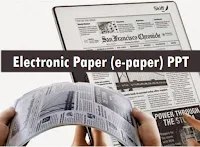Many electronic paper technologies hold static text and images indefinitely without electricity. Flexible electronic paper uses plastic substrates and plastic electronics for the display backplane. There is ongoing competition among manufacturers to provide full-color ability.
Applications of electronic visual displays include electronic pricing labels in retail shops, and digital signage, time tables at bus stations, electronic billboards, mobile phone displays, and e-readers able to display digital versions of books and e-paper magazines.
e-Paper Technologies
- Gyricon
- Electrophoretic display
- Electrowetting
- Electrofluidic display
- Interferometric modulator (Mirasol)
e-Paper Advantages and Disadvantages
Advantages of e-paper
- Paper-like Readability
- They are persistent without power, drawing current only when they change, which means low power consumption therefore batteries can be smaller and last longer.
- An electronic ink display module is thinner, lighter weight, and more robust than conventional LCD's.
- Electronic Paper is highly flexible and it is able to be twisted or bended into different curvatures. The Electronic Paper can be applied to different shapes of products, without being limited to being bonded to flat display panels.
- They are completely reflective requiring no backlight.
- They are inherently bi-stable for extended periods of time.
Disadvantages of e-paper
- Very low switching speed
- Electrochemical complexity
- Electronic paper technologies have a very low refresh rate compared to other low-power display technologies, such as LCD.
- A shadow of an image may be visible after refreshing parts of the screen. Such shadows are termed "ghost images", and the effect is termed "ghosting“.
Click here to Download e-paper ppt (Large File 18MB)


0 comments